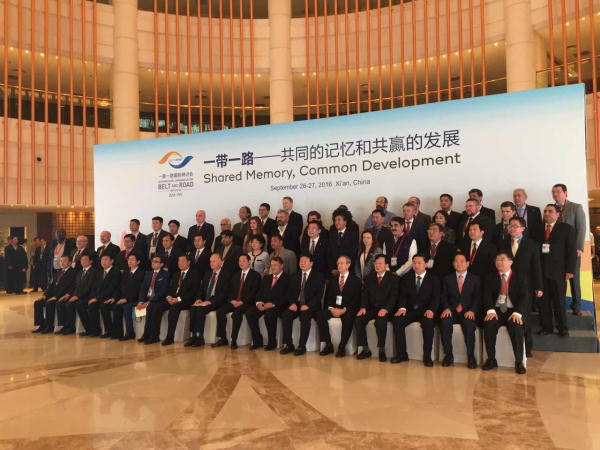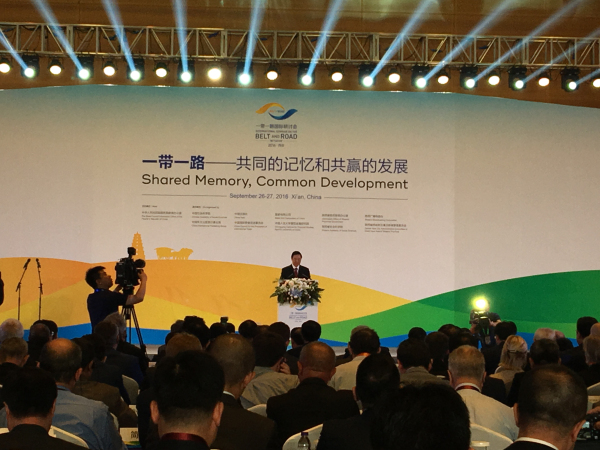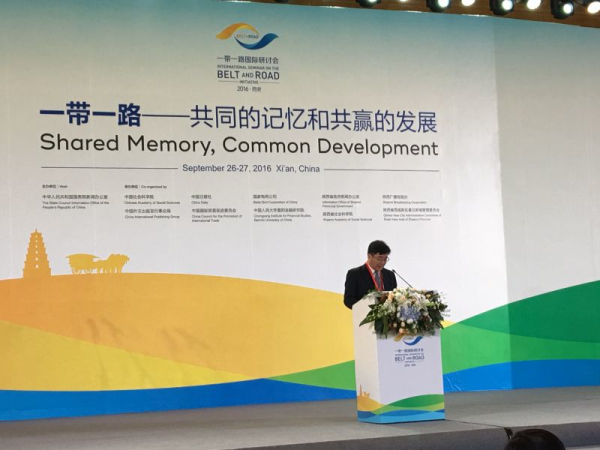Belt and Road
Your Present Location: PROGRAMS> Belt and RoadThe first authoritative report on "Belt and Road" three-year progress released
Source: China Daily Published: 2016-9-26

The seminar themed "the Belt and Road Initiative(BRI): Shared Memory and Common Development" was held in Xi`an on September 26th.[Photo provided to chinadaily.com.cn]
An international seminar themed "the Belt and Road Initiative(BRI): Shared Memory and Common Development" was held in Xi`an on September 26th. It was attended by over 400 guests including representatives of think tanks, enterprises and media from more than 30 countries. Liu Qibao, Head of the Publicity Department of the Communist Party of China, delivered a keynote speech at the opening ceremony.
A report titled "Adhering to the Planning, Orderly and Pragmatically Build the `Belt and Road` " was released, which was a result of the research team at Chongyang Institute for Financial Studies of Renmin University of China (RDCY), aiming to systematize and summarize the significant progress of BRI over the past three years and provide actionable ideas for its further implementation. As the leader of the research team, Renmin University of China(RUC) President Liu Wei introduced the report at the opening ceremony.
This report provides an overview from eight perspectives: BRI`s top-level design, related policy coordination, facilities connectivity, unimpeded trade, financial integration, people-to-people bond, China’s domestic efforts, as well as suggestions for BRI’s future growth. The report notes that over the past three years an array of key projects is underway, with a commitment to achieving common development and shared growth through joint consultation.
Two parallel roads, a global chorus
The report mentions that with full understanding of the interests and concerns of the countries and regions along the "Belt and Road" , the Initiative upholds the spirit of peace, cooperation, openness, inclusiveness, mutual learning and mutual benefit, and proposes five principles accordingly: the Initiative is in line with the purposes and principles of the UN Charter; the Initiative is open for cooperation, and is open to all countries and international and regional organizations for engagement; the Initiative is harmonious and inclusive; the Initiative follows market rules; and the Initiative seeks mutual benefit. That means China’s BRI is open and inclusive as well as mutually beneficial for all participants. It is a chorus all countries across the globe are welcome to join in. The Initiative calls for all countries and regions along the “Belt and Road” to participate, to work and share benefit together in a bid to realize mutually beneficial and sustainable development.
The Silk Road Economic Belt and the 21st-Century Maritime Silk Road are the two main routes of the BRI. On land, the Initiative will focus on jointly building a new Eurasian Land Bridge and developing China-Mongolia-Russia, China-Central Asia-West Asia, China-Pakistan, Bangladesh-China-India-Myanmar, and China-Indochina Peninsula economic corridors by taking advantage of international transport routes, relying on core cities along the "Belt and Road" and using key economic industrial parks as cooperation platforms. At sea, the Initiative will focus on jointly building smooth, secure and efficient transport routes connecting major sea ports along the "Belt and Road". In order to make greater progress of the BRI, we need to realize closer cooperation and connection between the land and maritime routes, the report says.

Liu Qibao, Head of the Publicity Department of the Communist Party of China, delivered a keynote speech at the opening ceremony.[Photo provided to chinadaily.com.cn]
Five major goals, outstanding progress
Policy coordination plays a critical role in supporting the BRI. China has been building policy coordination mechanism at various levels with countries along the "Belt and Road" over the past three years. By the end of June 2016, China had issued joint proposals and statements with 56 countries and regional organizations on bilateral cooperation for implementing the BRI and signed the relevant MoUs or agreements accordingly. Between September 2013 and August 2016, President Xi visited 37 countries (18 in Asia, 9 in Europe, 3 in Africa, 4 in Latin America and 3 in Oceania), where he officially promoted the idea of building the "Belt and Road" as a cooperation initiative and received warm response from concerned countries.
Facilities connectivity has been identified as one of the priorities for the BRI. Between the time the BRI was put forward by President Xi in 2013 and June 30, 2016 large state-owned enterprises such as China Railway Group Limited and China Communications Construction Company Limited signed construction contracts for 38 large demonstration projects of transport infrastructure, covering 26 countries and focusing on key routes, port cooperation and the improvement of infrastructure in developing countries.
China’s state-owned enterprises participated in the construction of 40 overseas energy projects, including power plants, electricity transmission facilities and oil and gas pipelines, covering 19 countries along the "Belt and Road". Chinese telecommunication service providers such as China Unicom, China Telecom and China Mobile are speeding up cross-border transmission projects in countries along the "Belt and Road" to expand international telecommunication infrastructure.
Unimpeded trade is a very important part in building the “Belt and Road”. Over the past three years, China and the “Belt and Road” countries have been working together to facilitate trade and investment activities. From June 2013 to June 2016, China recorded US$3.1 trillion worth of commodity trade along the "Belt and Road", which account for 26 percent of its total trade volume. As of June 30, 2016, China had invested US$51.1 billion in total in these countries, accounting for 12% of China’s overseas direct investment over the same period, and had launched 52 trade and economic cooperation zones in 18 countries along the "Belt and Road", with a total investment of US$15.6 billion.
Financial integration is an important underpinning for the successful implementation of the BRI. By June 30th, 2016, China Development Bank had set up an “Belt and Road” project pool involving over 900 projects from over 60 countries in transportation, energy, resources and others sectors. The Export-Import Bank of China holds an outstanding balance of over 1,000 projects involving roads, railways, ports, power resources, pipelines, communication, and industrial parks in the 49 countries along the "Belt and Road". The Export-Import Bank of China also recently signed over 500 projects. In addition, the use of RMB has been expanding in cross-border trade and investment. By June 30, 2016, cross-border RMB settlements between China and countries and regions along the “Belt and Road” had exceeded 2.63 trillion yuan.
People-to-people communication provides public support for implementing the BRI. Since the launch of the initiative three years ago, China has been, by upholding the spirit of friendly cooperation of the Silk Road, energetically developing cooperation on culture and education, tourism, health care and medical service, science and technology as well as exchanges among youths, political parties, governments and non-governmental individuals and organizations in countries and regions along the “Belt and Road”, thus winning public support for the implementation of the BRI.

Renmin University of China(RUC) President Liu Wei is delivering a speech.[Photo provided to chinadaily.com.cn]
Joint efforts, all-dimensional strategy
The report noted that the BRI is a long-term and systematic program, and China would not only be the initiator but also a responsible and reliable practitioner for steady, practical and orderly construction of the "Belt and Road". Therefore RDCY research team proposed five suggestions for BRI’s future growth.
First, building an overall planning and coordination mechanism for efficient and integrated progress. On the one hand, a "positive list"for the construction of the "Belt and Road" could be introduced to guide all sides to identify the trends in building the "Belt and Road" and promote more reasonable policy expectations to be formed at different levels of governments. On the other hand, a "negative list" for the construction of the "Belt and Road" should also be issued to confirm forbidden fields and fully inspire initiative and creativity of participants in building the “Belt and Road”.
Second, adhering to principle of long-term consistent progress and encouraging innovative mechanisms and platforms. Since there’s no existing experience for reference, efforts should be made to explore ways of innovative construction.
Third, telling BRI stories to boost cohesion among countries for the construction of the "Belt and Road". China should give full interpretation of the BRI’s connotation and denotation and clearly show the positive effects of the BRI, which would facilitate the deepening of international cooperation. This would also help shape mainstream understanding of the BRI among Chinese public, and help reduce misunderstanding toward BRI abroad.
Fourth, utilizing the global Chinese network to tap into international talent reserves. Overseas Chinese could serve as an important link to help reduce the gap between China and the countries where they reside. A productive network of global Chinese talent should be developed for the progress of the “Belt and Road”.
Fifth,improving business support system to provide all-around and effective assistance. Comprehensive support for Chinese enterprises in terms of investment banking services, business trust, administration, legal affairs, auditing, consulting and investigation should be in place, so as to help Chinese enterprises prosper while going global. This would also offer powerful back-up for the development of the BRI.
Contribute wisdom, taking on think tanks’ role
RUC always attaches great importance to the research of "Belt and Road" strategy, Liu emphasized when he released the report. basing on the comprehensive advantages on disciplines of arts, humanities and social science, and mechanism innovation, RUC devoted to the building of first-class think tanks with Chinese characteristics, and made effort to provide powerful research results and policy suggestions on the “Belt and Road” construction.
Over the past three years, RUC has investigated more than 30 countries and regions along the "Belt and Road" . After the launch of "Vision and proposed actions outlined on jointly building Silk Road Economic Belt and 21st-Century Maritime Silk Road" on March 28th, 2015, RUC published the first monograph " `Belt and Road Initiative`: opportunities and Challenges" which has been translated into over 10 different languages, hosted a number of forums such as "Belt and Road Economic Forum", "Silk Road Economic Belt Cities International Forum" and " `Belt and Road` strategy and RMB internationalization", built the database of the "Belt and Road", and set up a research and survey team.
As one of the authors of this report, the Executive Dean Wang Wen pointed out at an interview, “RDCY was the Executive Director of the Chinese Think Tank Cooperation Alliance for the “Belt and Road”, and the leading think tank to jointly build “Belt and Road” through the cooperation of the official and academic organizations between China and Iran. RDCY had successfully organized a number of think tanks’ dialogues with Iran, Turkey, India, Nepal, the United States, Kazakhstan and other countries, and visited more than 30 countries over a hundred of cities and counties. RDCY plays an important role on the construction of the “Belt and Road” and gets fruitful results over the past three years”. Wang emphasized that we hope to tell China’s stories well with more active and lively examples, and contribute our wisdom and strength in promoting the understanding of BRI across the world and boosting the development of Chinese public diplomacy.
Key Words: Belt and Road; seminar; RDCY























































































 京公网安备 11010802037854号
京公网安备 11010802037854号





